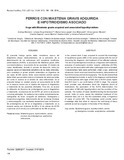Perros con miastenia gravis adquirida e hipotiroidismo asociado

Voir/
Date
2018-03Auteur
Palabras Clave
Miastenia gravis, Hipotiroidismo, Canino, Bromuro de piridostigmina, Acetilcolina, AnticuerposMyasthenia gravis, Hypothyroidism, Canine, Pyridostigmine bromide, Acetylcholine, Antibodies
Metadatos
Afficher la notice complèteRésumé
El presente trabajo aporta datos novedosos acerca del diagnóstico (toque medicamentoso), de la aplicación de la
determinación de los anticuerpos anti receptores nicotínicos postsinápticos (ACRA), la asociación de Miastenia gravis (MG)
con hipotiroidismo y la evolución de los pacientes. El número de casos identificados durante el periodo de desarrollo limita (en
algunos casos) el tratamiento estadístico de los datos obtenidos, pero constituye el primer estudio sistemático en Argentina de
los casos de MG canina. Estos conocimientos podrían aportar datos útiles que permiten mejorar el bienestar de estos pacientes
así como el avance en el estudio de esta enfermedad. En el presente trabajo se planteó ampliar el conocimiento de la MG
en la especie canina con el objetivo de mejorar el diagnóstico y tratamiento de los pacientes afectados. Para ello, se evaluó
la utilización de Bromuro de piridostigmina para el diagnóstico y tratamiento, la presencia de los ACRA, así como la asociación
con otras patologías. Se realizaron las pruebas complementarias: radiografías de tórax, ecografía de abdomen, hemograma y
bioquímica sanguínea, determinación de las hormonas tiroideas y electromiografía. Los resultados demostraron que i) el Bromuro
de piridostigmina es útil en el diagnóstico y tratamiento en la especie canina con síntomas de MG y ii) los valores de ACRA
superiores a 0,5 nmol/L son confirmatorios de MG en perros.
Colecciones
Información Adicional
| Otros Títulos | Dogs with Miastenia gravis acquired and associated hypothyroidism |
| Editor | SABER-ULA |
| ISSN | 0798-2259 |
| ISSN Electrónico | 2477-944X |
| Resumen en otro Idioma | In the present work it was proposed to expand the knowledge of myasthenia gravis (MG) in the canine species with the aim of improving the diagnosis and treatment of the affected patients. The use of pyridostigmine bromide as a diagnosis and treatment, presence of postsynaptic nicotinic receptor antibodies (ACRA), as well as the association with other pathologies were evaluated. Complementary tests were performed: chest x-rays, abdominal ultrasound, blood count and blood biochemistry, determination of thyroid hormones and electromyography. The results showed that i) pyridostigmine bromide is useful in the diagnosis and treatment of canine species with signs of MG and ii) ACRA values higher than 0.5 nmol / L are confirmatory of MG in dogs. The present work provides new information about the diagnosis (touch of medication), the application of the ACRA determination, the association of MG with hypothyroidism and the evolution of the patients. The number of cases identified during the development period, limits (in some cases) the statistical treatment of the obtained data, but it is the first systematic study in Argentina of cases of canine MG. This knowledge could provide useful knowledge data that allow to improve the well-being of these patients as well as progress in the study of this disease. |
| Colación | 136-138 |
| País | Venezuela |
| Institución | Universidad del Zulia (LUZ) Universidad de Los Andes (ULA) |
| Publicación Electrónica | Revista Científica |





